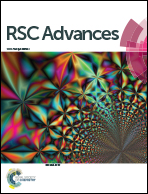Amorphous PtNiP particle networks of different particle sizes for the electro-oxidation of hydrazine†
Abstract
The design of alloy networks is an important fundamental and applied research challenge in the area of catalysis due to the high surface area, gas permeability and electrical conductivity of alloy network structures. Herein amorphous PtNiP particle networks were prepared via the NaBH4 co-reduction process. Moreover, the reaction temperature control from 0 °C to 80 °C was shown to be a powerful tool for the ‘tuning’ of particle sizes. Electron microscopy, X-ray diffraction and selected area electron diffraction were used to show the morphology, the amorphous behavior and the changes in particle size of the particle networks. The results of the electrochemical performance showed that the amorphous PtNiP particle networks had better catalytic activity towards hydrazine oxidation compared to the Pt and PtNi networks. The electrocatalytic activity reached a peak value, 0.62 mA at −0.63 V, at a PtNiP-50 electrode. The correlation between the particle size of the amorphous PtNiP particle networks and their electrocatalytic activity for the hydrazine oxidation reaction provided the opportunity to develop highly active electrocatalysts for hydrazine fuel cells.


 Please wait while we load your content...
Please wait while we load your content...